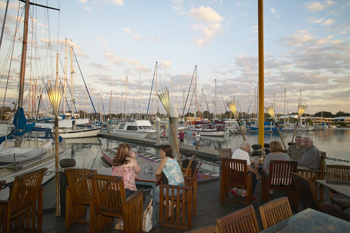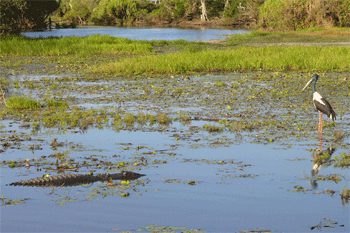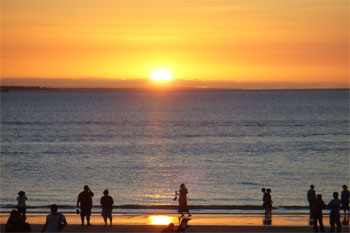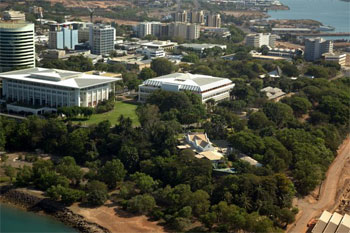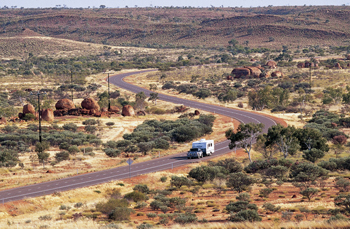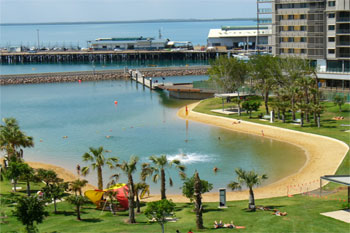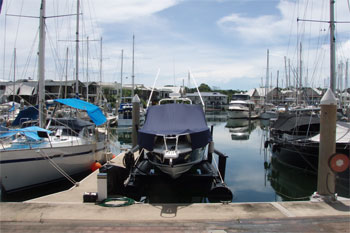
Darwin Weather is two seasons being Dry Season and the Wet Season

The main link we refer to is the government link at
http://www.bom.gov.au/
It has a very good search link
Best time to visit Darwin
We suggest considering the following for different reasons.
The 'Dry Season' - May till October - (as pictured
right) because the days are warm and the sky is blue and the night's
are cool.
The average maximum temperature for June-July is approx. 32°C

Another time to visit Darwin
The 'Wet Season' - Now marketed as
'Tropical Summer' from November till 1st May - 'rightly so' simply
because it doesn't always rain.

November to December - However 'build up' storms are impressive and lightning strikes are frequent. In fact the Top End of Australia records more lighting strikes per year than any other place on earth.

Kakadu National Park - Seasons
But Australia's Kakadu sees seasons of varied extremes
- so varied, in fact, that the park's longtime aboriginal inhabitants
have divided the year into six distinct seasons.
See more on Kakadu at http://www.kakadunationalparkaustralia.com/
Gunumeleng Pre-Monsoon Storm Season
Gunumeleng, from mid-October to late December, may in fact last
from a few weeks to several months. It is the pre-monsoon season
of hot weather that becomes more and more humid. Thunderstorms
build in the afternoons and scattered showers bring a tinge of
green to the dry land. As the streams begin to run, acidic water
that washes from the floodplains can cause fish to die in billabongs
with low oxygen levels. Waterbirds spread out as surface water
and new growth become more widespread. Barramundi move from the
waterholes downstream to the estuaries to breed. This was when
Bininj/Mungguy moved camp from the floodplains to the stone country,
to shelter from the violent storms of the coming wet season.
Gudjewg - Monsoon Season
Gudjewg, from January to March, can be described as the 'true'
wet season. It is a time of thunderstorms, heavy rain and flooding.
The heat and humidity generate an explosion of plant and animal
life. Spear grass grows to over 2 metres tall and creates a silvery-green
hue throughout the woodlands. Magpie geese nest in the sedgelands.
Flooding may cause goannas, snakes and rats to seek refuge in
the trees. Eggs and stranded animals are a good food source for
Bininj/Mungguy during this time.
Banggereng - Knock 'em down storm Season
Banggerreng, in April, is the season when the rain clouds have
dispersed and clear skies prevail. The vast expanses of floodwater
recede and streams start to run clear. Most plants are fruiting
and animals are caring for their young. Violent, windy storms
early in this season flatten the spear grass; they are called
'knock 'em down' storms.
Yegge - Cooler but still humid Season
Yegge, from May to mid-June, is relatively cool with low humidity.
Early morning mists hang low over the plains and waterholes. The
shallow wetlands and billabongs are carpeted with water lilies.
Drying winds and flowering Darwin woolly butt tell Bininj/Mungguy
that it is time to start burning the woodlands in patches to 'clean
the country' and encourage new growth for grazing animals.
Wurrgeng - Cold Weather Season
Wurrgeng, from mid-June to mid-August, is the 'cold weather' time;
humidity is low, daytime temperatures are around 30°C and night-time
temperatures are around 17°C. Most creeks stop flowing and the
floodplains quickly dry out. Burning continues, extinguished by
the dew at night. By day, birds of prey patrol the fire lines
as insects and small animals try to escape the flames. Magpie
geese, fat and heavy after weeks of abundant food, and a myriad
of other waterbirds crowd the shrinking billabongs.
Gurrung - Hot Dry Weather
Gurrung, from mid-August to mid-October, is hot and dry. It is
still 'goose time' but also time for Bininj/Mungguy to hunt file
snakes and long-necked turtles. Sea turtles lay their eggs on
the sandy beaches of Field Island and West Alligator Head and
goann as rob their nests sometimes. White-breasted wood swallows
arrive as thunderclouds build, signalling the return of Gunumeleng.
Cyclones - January to March, can be
described as the 'true' wet season. It is a time of thunderstorms,
heavy rain and flooding.
The great thing about Darwin many our clients don't realise
is we have some of the best preparation procedures in the world
- seriously the folks at NTES
are amazing.
Also did you know all the new buildings since Cyclone Tracy (1974)
have to be cyclone coded that's why the property prices are a
bit higher.
Such as screws in the roof instead of nails and also extra rods
in the block work.
Now for investors this is great your house will last a few hundreds
more years we reckon.
If you have lived here for a while you will mostly say you either
don't mind the wet or it doesn't worry you.
We asked around 100 folks for this web site and 3 said they were
unsure of the season because of cyclones.
Now these 3 had only been living here a year.
The rest knew that Darwin has good warning levels, good access
in and out of the city, very good preparation measures and 99%
of the time they miss Darwin by 100-200klm and were back out to
sea.
The ones that left a mark on Darwin city was Cyclone Tracy (1974)
and Cyclone Gretel (1983).
http://www.bom.gov.au/
(You are linking out to another site here)
For further information on warning services, go to the “Tropical
Cyclone Information” section of the web page at: http://www.bom.gov.au/nt/warnings/
(You are linking out to another site here)
Darwin - We have offered the links to the www.bom.gov.au
the weather site. http://www.bom.gov.au/
-

4wd Rooftop Tent Camper
4wd Camper hire from Darwin -
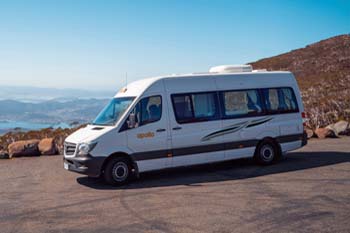
Campervan hire Darwin
Travel in comfort in a campervan -
